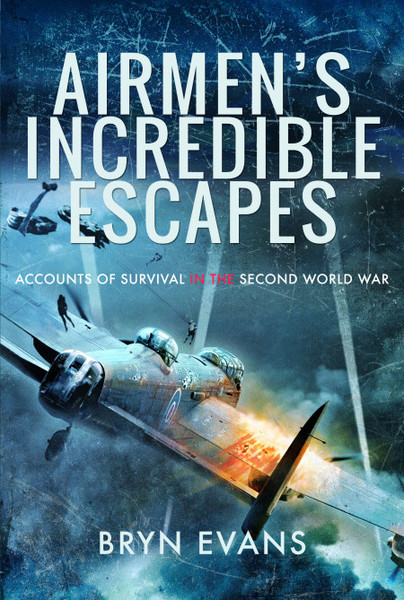Author Guest Post: Bryn Evans
Airmen’s Incredible Escapes
American and other Allied aircrew in the Second World War cheated death in inspirational struggles to survive.
In the latest book by Australian author Bryn Evans, Airmen’s Incredible Escapes, the resilience and self-sacrifice of the human spirit belie the horrors of war, in a message for us today and for future generations.
In the Second World War to achieve air superiority the cost in Allied aircraft and casualties was horrific in all theatres, notably the European, Far East and Pacific. Some airmen survived being shot down, baling out, crashing their aircraft into the ground, ditching into water, or evading the enemy while on the run, and did so in countless number of ways to make a miraculous escape. Their experiences, often overcoming extraordinary danger and hardship, in many cases remained untold not just for the duration of the War but for many years.
When an aircraft was shot down, an unknown number of aircrew, while floating down by parachute, were machine-gunned to death by enemy fighters. If airmen survived baling out, or a crashed landing, life or death remained a lottery. They became desperate to evade being captured by enemy forces. Many who were taken prisoner on the ground, were summarily executed by enemy forces or their civilian supporters. In German cities many civilians looked upon Allied aircrew as ‘terrorflieger’, and subjected downed airmen to the instant justice of the mob.
In one of the stories in Airmen’s Incredible Escapes in June 1942 Lieutenant Gene Rehrer of the 39th Pursuit Squadron of the USAAF took off from the squadron’s airfield near Port Moresby in New Guinea. In a scramble to meet fighters of the battle-hardened Imperial Japanese Air Force and, in his first combat encounter, the probability was high that his inexperience might prove fatal. As if pre-ordained, an enemy fighter attacked Rehrer, sending his P.39 Airacobra fighter into an inverted spin. His aircraft pitched into a death dive towards the blanket of the thick New Guinea jungle.
Also in June 1942 on a homeward return flight following a raid on Essen, a Wellington bomber of RAF Bomber Command, is crossing the Dutch coast south of Rotterdam, when it is attacked by an enemy night-fighter. A cannon shell explodes at the feet of Wireless Operator Eric Maher, where he stands in the aircraft’s astro-hatch, and hits the main spar of the aircraft. Red hot splinters shower him and he falls on the floor, near unconscious. The bomber’s navigator assists him to get to the escape hatch. Critically injured in both legs, Maher drops into the North Sea. His parachute wraps around his head, dragging him deeper and deeper under the water – yet swimming to the Dutch coast is the only option!
In 1944 off the coast of Queensland Australia a Bell P-39 Airacobra was below 500 feet, and plummeting into he sea, when Lieutenant Sponenbergh of No 80 Squadron, 8th Fighter Group, USAAF, baled out. There was no time for his parachute to fully open out, and he went down deep. When Sponenbergh eventually surfaced like a cork, he found himself entangled in the canopy’s lines, and his Mae West life vest was not inflating. He prayed for someone to save him.
In a bombing raid in February 1944 on Japanese occupied New Britain, an island north east of New Guinea, an explosion and fire in an RAAF Catalina flying boat, caused by a malfunction of a reconnaissance flare, sends the aircraft crashing into the sea. Australian Flying Officer Allan Liedl and three others of the aircrew of the Catalina spent nearly two months lost in the jungle evading capture by the Japanese. Living solely off local vegetation they became too weak to move any more, until by chance a local villager caught sight of them. Despite the close proximity of Japanese troops, and the threat of execution and destruction of the man’s village and families, would he and his village inhabitants help them?
*
These stories and many others in Airmen’s Incredible Escapes are astounding, and each one in many and different ways unique. Perhaps the most remarkable and wonderful aspect is that so many airmen owed their survival to the help and kindness of perfect strangers. Amidst the hate, death, destruction, and worldwide misery of the Second World War, humanity’s instinctive kindness, care and selfless generosity towards fellow human beings still thrived, and was found in some most unlikely places. Aircrew brought down in enemy territory were only able to survive with assistance from either local civilians or enemy forces.
The civilian ‘Helpers’ of shot-down airmen in each country risked their lives and their families. If caught, in Nazi occupied Europe it meant torture at the hands of the Gestapo to provide information on other resistance members. Then if they survived the torture, they and their families would be either sent to a concentration camp or executed. The ‘Helpers’ in all countries knew the risks they were taking. Like the airmen they too were hostage to fortune, and their courage was just as incredible.
The airmen and ‘Helpers’ in these stories found within themselves a fortitude and resilience to live each day as if it were their last. The stories in Airmen’s Incredible Escapes are an inspiration, not least for us all in this time of the global pandemic.
***
The early reviews of Airmen’s Incredible Escapes are excellent, and Bryn has begun research for a follow-up sequel of similar, miraculous survival stories. Veterans, their families and friends, who would like to contribute, can contact Bryn by email – bryn.evans@ozemail.com.au.
Bryn Evans
December 2020

You can order a copy here.

